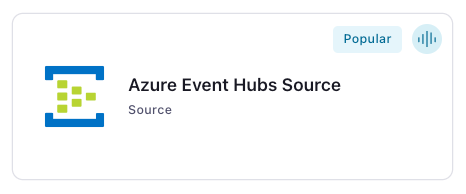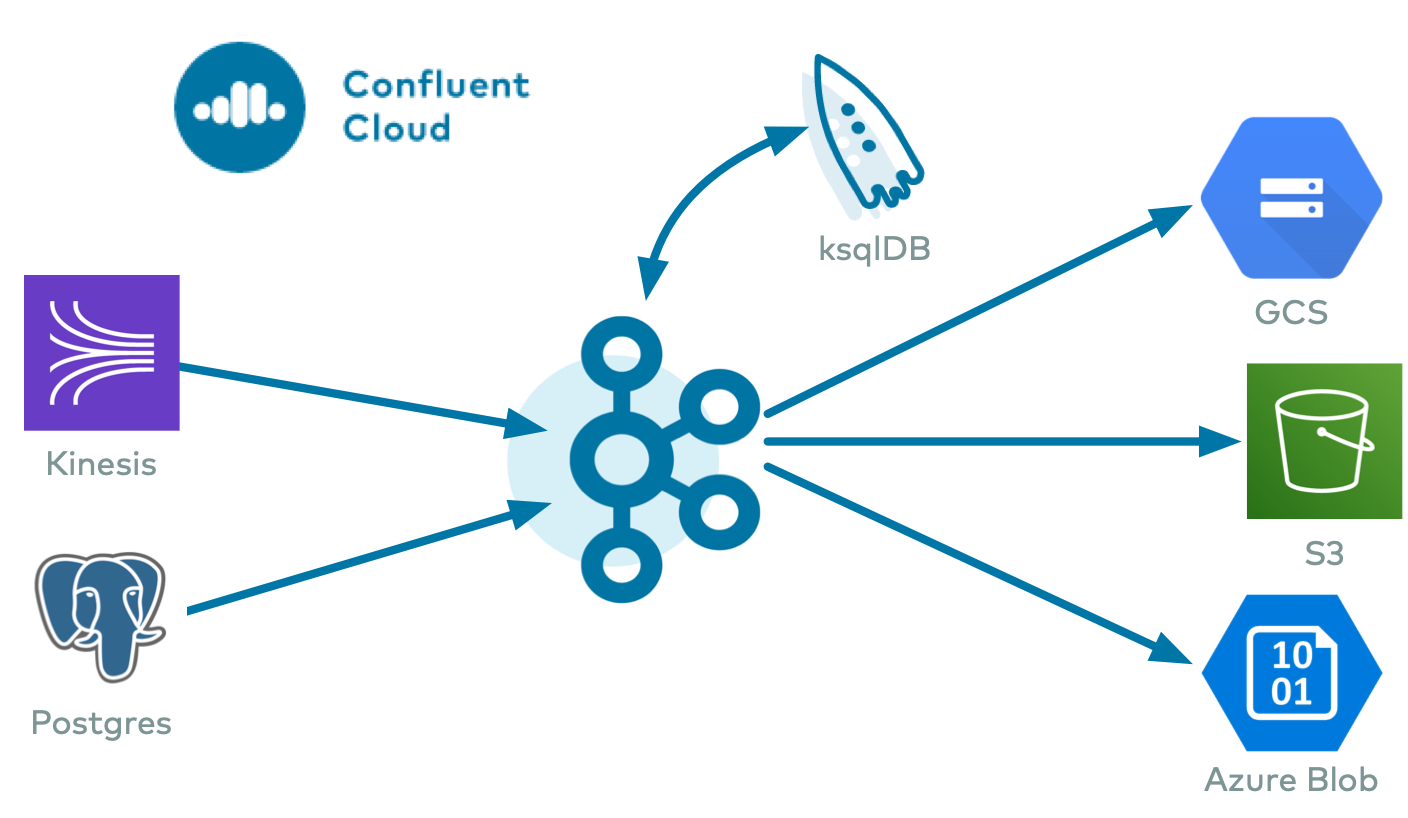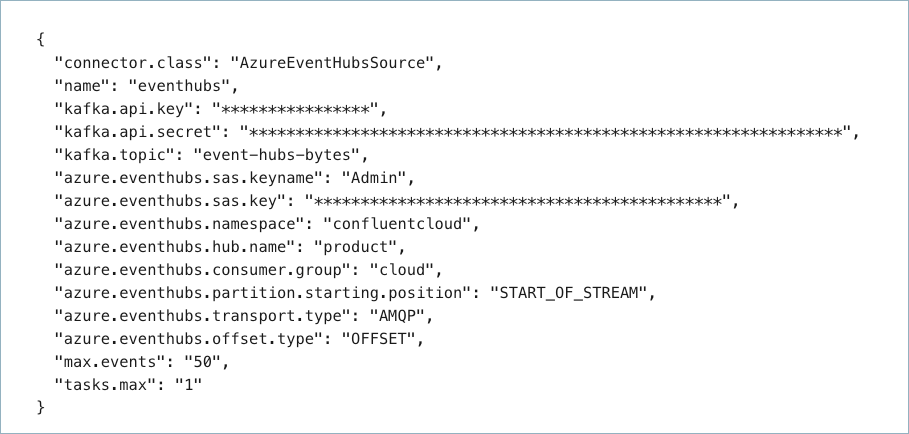Azure Event Hubs Source Connector for Confluent Cloud
The fully-managed Azure Event Hubs Source connector for Confluent Cloud is used to poll data from Azure Event Hubs and persist the data to an Apache Kafka® topic. For additional information about Azure Event Hubs, see the Azure Event Hubs documentation. The connector fetches records from Azure Event Hubs through a subscription. The connector uses a BytesArrayConverter internally to transform data elements into byte records.
Confluent Cloud is available through Azure Marketplace or directly from Confluent.
Note
This Quick Start is for the fully-managed Confluent Cloud connector. If you are installing the connector locally for Confluent Platform, see Azure Event Hubs Source connector for Confluent Platform.
If you require private networking for fully-managed connectors, make sure to set up the proper networking beforehand. For more information, see Manage Networking for Confluent Cloud Connectors.
Features
The Azure Event Hubs Source connector provides the following features:
Topics created automatically: The connector can automatically create Kafka topics.
Select configuration properties:
azure.eventhubs.partition.starting.positionazure.eventhubs.consumer.groupazure.eventhubs.transport.typeazure.eventhubs.offset.typemax.events(defaults to 50 with a maximum of 499 events)
Provider integration support: The connector supports Microsoft’s native identity authorization using Confluent Provider Integration. For more information about provider integration setup, see the connector authentication.
For more information and examples to use with the Confluent Cloud API for Connect, see the Confluent Cloud API for Connect Usage Examples section.
Limitations
Be sure to review the following information.
For connector limitations, see Azure Event Hubs Source Connector limitations.
If you plan to use one or more Single Message Transforms (SMTs), see SMT Limitations.
If you plan to use Confluent Cloud Schema Registry, see Schema Registry Enabled Environments.
Quick Start
Use this quick start to get up and running with the Confluent Cloud Azure Event Hubs Source connector.
- Prerequisites
Authorized access to a Confluent Cloud cluster on Amazon Web Services (AWS), Microsoft Azure (Azure), or Google Cloud.
At least one topic must exist before creating the connector.
The Confluent CLI installed and configured for the cluster. See Install the Confluent CLI.
An Azure account with an existing Event Hubs Namespace, Event Hub, and Consumer Group.
An Azure Event Hubs Shared Access Policy with its policy name and key.
Kafka cluster credentials. The following lists the different ways you can provide credentials.
Enter an existing service account resource ID.
Create a Confluent Cloud service account for the connector. Make sure to review the ACL entries required in the service account documentation. Some connectors have specific ACL requirements.
Create a Confluent Cloud API key and secret. To create a key and secret, you can use confluent api-key create or you can autogenerate the API key and secret directly in the Cloud Console when setting up the connector.
Using the Confluent Cloud Console
Step 1: Launch your Confluent Cloud cluster
To create and launch a Kafka cluster in Confluent Cloud, see Create a kafka cluster in Confluent Cloud.
Step 2: Add a connector
In the left navigation menu, click Connectors. If you already have connectors in your cluster, click + Add connector.
Step 3: Select your connector
Click the Azure Event Hubs Source connector card.

Step 4: Enter the connector details
Note
Make sure you have all your prerequisites completed.
An asterisk ( * ) designates a required entry.
At the Add Azure Event Hubs Source Connector screen, complete the following:
Select the topic you want to send data to from the Topics list. To create a new topic, click +Add new topic.
Select the way you want to provide Kafka Cluster credentials. You can choose one of the following options:
My account: This setting allows your connector to globally access everything that you have access to. With a user account, the connector uses an API key and secret to access the Kafka cluster. This option is not recommended for production.
Service account: This setting limits the access for your connector by using a service account. This option is recommended for production.
Use an existing API key: This setting allows you to specify an API key and a secret pair. You can use an existing pair or create a new one. This method is not recommended for production environments.
Note
Freight clusters support only service accounts for Kafka authentication.
Click Continue.
Configure the authentication properties:
Azure credentials
Authentication method: Under Azure credentials, select how you want to authenticate with the database:
If you select SAS Key (default), enter the following Azure Event Hubs details:
Shared access policy name: Shared access policy name to use for access authentication.
Shared access key: Shared access key to use for access authentication.
If you select Microsoft Entra ID application, enter the following Azure Event Hubs details:
Under the Provider integration dropdown, select an existing integration name that has access to your Azure resource required to run this connector. For more information, see Manage an Microsoft Azure Provider Integration.
Provider Integration: Select an existing integration name that has access to your Azure resource required to run this connector. Required for
Microsoft Entra ID applicationauthentication.
How should we connect to your data?
Shared access policy name: Shared access policy name to use for access authentication. Required for
SAS Keyauthentication.Shared access key: Shared access key to use for access authentication. Required for
SAS Keyauthentication.Event Hubs namespace: Event Hubs namespace to connect to.
Event Hub name: Event Hub to read from.
Azure Event Hubs consumer group: Specific consumer group to read from.
Azure Event Hubs Domain: Domain of the Event Hub to connect to. Valid options are
servicebus.windows.net(default),servicebus.usgovcloudapi.net,servicebus.cloudapi.de, orservicebus.chincloudapi.cn.
Click Continue.
Connection details
Azure Event Hubs transport type: Event Hubs communication transport type.
Azure Event Hubs offset type: Offset type to use to keep track of events.
Show advanced configurations
Additional Configs
Value Converter Decimal Format: Specify the JSON/JSON_SR serialization format for Connect DECIMAL logical type values with two allowed literals: BASE64 to serialize DECIMAL logical types as base64 encoded binary data and NUMERIC to serialize Connect DECIMAL logical type values in JSON/JSON_SR as a number representing the decimal value.
Value Converter Reference Subject Name Strategy: Set the subject reference name strategy for value. Valid entries are DefaultReferenceSubjectNameStrategy or QualifiedReferenceSubjectNameStrategy. Note that the subject reference name strategy can be selected only for PROTOBUF format with the default strategy being DefaultReferenceSubjectNameStrategy.
Errors Tolerance: Use this property if you would like to configure the connector’s error handling behavior. WARNING: This property should be used with CAUTION for SOURCE CONNECTORS as it may lead to dataloss. If you set this property to ‘all’, the connector will not fail on errant records, but will instead log them (and send to DLQ for Sink Connectors) and continue processing. If you set this property to ‘none’, the connector task will fail on errant records.
Value Converter Connect Meta Data: Allow the Connect converter to add its metadata to the output schema. Applicable for Avro Converters.
Value Converter Value Subject Name Strategy: Determines how to construct the subject name under which the value schema is registered with Schema Registry.
Key Converter Key Subject Name Strategy: How to construct the subject name for key schema registration.
Auto-restart policy
Enable Connector Auto-restart: Control the auto-restart behavior of the connector and its task in the event of user-actionable errors. Defaults to
true, enabling the connector to automatically restart in case of user-actionable errors. Set this property tofalseto disable auto-restart for failed connectors. In such cases, you would need to manually restart the connector.
Connection details
Default starting position: Default reset position if no offsets are stored.
Max events: Maximum number of events to read when polling an Event Hub partition.
Transforms
Single Message Transforms: To add a new SMT, see Add transforms. For more information about unsupported SMTs, see Unsupported transformations.
Click Continue
Based on the number of topic partitions you select, you will be provided with a recommended number of tasks.
To change the number of tasks, use the Range Slider to select the desired number of tasks.
Click Continue.
Step 5: Check the Kafka topic
After the connector is running, verify that messages are populating your Kafka topic.
For more information and examples to use with the Confluent Cloud API for Connect, see the Confluent Cloud API for Connect Usage Examples section.
Using the Confluent CLI
Complete the following steps to set up and run the connector using the Confluent CLI.
Important
Make sure you have all your prerequisites completed.
You must create topic names before creating and launching this connector. Use the following command to create a topic using the Confluent CLI.
confluent kafka topic create <topic-name>
Step 1: List the available connectors
Enter the following command to list available connectors:
confluent connect plugin list
Step 2: List the connector configuration properties
Enter the following command to show the connector configuration properties:
confluent connect plugin describe <connector-plugin-name>
The command output shows the required and optional configuration properties.
Step 3: Create the connector configuration file
Create a JSON file that contains the connector configuration properties. The following example shows required and optional connector properties.
{
"connector.class": "AzureEventHubsSource",
"name": "azure-eventhubs-source",
"kafka.auth.mode": "KAFKA_API_KEY",
"kafka.api.key": "<my-kafka-api-key>",
"kafka.api.secret": "<my-kafka-api-secret>",
"azure.eventhubs.sas.keyname": "<-my-shared-access-policy name->",
"azure.eventhubs.sas.key": "<my-shared-access-key>",
"azure.eventhubs.namespace": "<my-eventhubs-namespace>",
"azure.eventhubs.hub.name": "<my-eventhub-name>",
"azure.eventhubs.consumer.group": "<my-eventhub-consumer-group>",
"kafka.topic": "<my-topic-name>",
"azure.eventhubs.partition.starting.position": "START_OF_STREAM",
"azure.eventhubs.transport.type": "AMQP",
"azure.eventhubs.offset.type": "OFFSET",
"max.events": "50",
"tasks.max": "1"
}
Note the following property definitions:
"name": Sets a name for your new connector."connector.class": Identifies the connector plugin name.
"kafka.auth.mode": Identifies the connector authentication mode you want to use. There are two options:SERVICE_ACCOUNTorKAFKA_API_KEY(the default). To use an API key and secret, specify the configuration propertieskafka.api.keyandkafka.api.secret, as shown in the example configuration (above). To use a service account, specify the Resource ID in the propertykafka.service.account.id=<service-account-resource-ID>. To list the available service account resource IDs, use the following command:confluent iam service-account list
For example:
confluent iam service-account list Id | Resource ID | Name | Description +---------+-------------+-------------------+------------------- 123456 | sa-l1r23m | sa-1 | Service account 1 789101 | sa-l4d56p | sa-2 | Service account 2
"azure.eventhubs.partition.starting.position": (Optional) Sets the starting position in the Event Hub if no offsets are stored and a reset occurs. The value can beSTART_OF_STREAMorEND_OF_STREAM. If no property is entered, the configuration defaults toSTART_OF_STREAM.Note
The Azure Event Hub Source connector uses
x-opt-kafka-keykey-value pair as the partition key when the Azure SDKEventData.PartitionKeyproperty is null and when thex-opt-kafka-keyis present."azure.eventhubs.transport.type": (Optional) Sets the transport type for communicating with Azure Event Hubs. The value can beAMQPorAMQP_WEB_SOCKETS. AMQP (over TCP) uses port 5671. AMQP over web sockets uses port 443. If no property is entered, the configuration defaults toAMQP."azure.eventhubs.offset.type": (Optional) Sets the offset type used to keep track of events. The value can beOFFSET(the Azure Event Hubs offset for the event) orSEQ_NUM(the sequence number of the event). If no property is entered, the configuration defaults toOFFSET."max.events": (Optional) The maximum number of events to read from an Event Hub partition when polling. If no property is entered, the configuration defaults to50.499is the maximum number of events.
Single Message Transforms: See the Single Message Transforms (SMT) documentation for details about adding SMTs. See Unsupported transformations for a list of SMTs that are not supported with this connector.
See Configuration Properties for all property values and definitions.
Step 4: Load the properties file and create the connector
Enter the following command to load the configuration and start the connector:
confluent connect cluster create --config-file <file-name>.json
For example:
confluent connect cluster create --config-file az-event-hubs.json
Example output:
Created connector azure-eventhubs-source lcc-ix4dl
Step 5: Check the connector status
Enter the following command to check the connector status:
confluent connect cluster list
Example output:
ID | Name | Status | Type
+-----------+--------------------------+---------+--------+
lcc-ix4dl | azure-eventhubs-source | RUNNING | source
Step 6: Check the Kafka topic.
After the connector is running, verify that messages are populating your Kafka topic.
For more information and examples to use with the Confluent Cloud API for Connect, see the Confluent Cloud API for Connect Usage Examples section.
Configuration Properties
Use the following configuration properties with the fully-managed connector. For self-managed connector property definitions and other details, see the connector docs in Self-managed connectors for Confluent Platform.
Note
These are properties for the fully-managed cloud connector. If you are installing the connector locally for Confluent Platform, see Azure Event Hubs Source Connector for Confluent Platform.
Azure credentials
provider.integration.idAzure provider-integration to mint Microsoft Entra ID application tokens.
Type: string
Importance: high
authentication.methodHow Confluent Cloud authenticates with Azure.
Type: string
Default: SAS Key
Valid Values: Microsoft Entra ID application, SAS Key
Importance: high
azure.eventhubs.sas.keynameShared access policy name to use for access authentication.
Type: string
Importance: high
azure.eventhubs.sas.keyShared access key to use for access authentication.
Type: password
Importance: high
How should we connect to your data?
nameSets a name for your connector.
Type: string
Valid Values: A string at most 64 characters long
Importance: high
azure.eventhubs.namespaceEvent Hubs namespace to connect to.
Type: string
Importance: high
azure.eventhubs.hub.nameEvent Hub to read from.
Type: string
Importance: high
azure.eventhubs.consumer.groupSpecific consumer group to read from.
Type: string
Default: $Default
Importance: low
azure.eventhubs.domainSpecifies the domain of the Event Hub to connect to. Available options include: servicebus.windows.net, servicebus.usgovcloudapi.net, servicebus.cloudapi.de, servicebus.chinacloudapi.cn. Default is servicebus.windows.net.
Type: string
Default: servicebus.windows.net
Importance: low
Kafka Cluster credentials
kafka.auth.modeKafka Authentication mode. It can be one of KAFKA_API_KEY or SERVICE_ACCOUNT. It defaults to KAFKA_API_KEY mode, whenever possible.
Type: string
Valid Values: SERVICE_ACCOUNT, KAFKA_API_KEY
Importance: high
kafka.api.keyKafka API Key. Required when kafka.auth.mode==KAFKA_API_KEY.
Type: password
Importance: high
kafka.service.account.idThe Service Account that will be used to generate the API keys to communicate with Kafka Cluster.
Type: string
Importance: high
kafka.api.secretSecret associated with Kafka API key. Required when kafka.auth.mode==KAFKA_API_KEY.
Type: password
Importance: high
Which topic do you want to send data to?
kafka.topicIdentifies the topic name to write the data to.
Type: string
Importance: high
Connection details
azure.eventhubs.partition.starting.positionDefault reset position if no offsets are stored.
Type: string
Default: START_OF_STREAM
Importance: medium
azure.eventhubs.transport.typeEvent Hubs communication transport type.
Type: string
Default: AMQP
Importance: low
azure.eventhubs.offset.typeOffset type to use to keep track of events
Type: string
Default: OFFSET
Importance: medium
max.eventsMaximum number of events to read when polling an Event Hub partition.
Type: int
Default: 50
Valid Values: [1,…,500]
Importance: low
Number of tasks for this connector
tasks.maxMaximum number of tasks for the connector.
Type: int
Valid Values: [1,…]
Importance: high
Additional Configs
header.converterThe converter class for the headers. This is used to serialize and deserialize the headers of the messages.
Type: string
Importance: low
producer.override.compression.typeThe compression type for all data generated by the producer. Valid values are none, gzip, snappy, lz4, and zstd.
Type: string
Importance: low
producer.override.linger.msThe producer groups together any records that arrive in between request transmissions into a single batched request. More details can be found in the documentation: https://docs.confluent.io/platform/current/installation/configuration/producer-configs.html#linger-ms.
Type: long
Valid Values: [100,…,1000]
Importance: low
value.converter.allow.optional.map.keysAllow optional string map key when converting from Connect Schema to Avro Schema. Applicable for Avro Converters.
Type: boolean
Importance: low
value.converter.auto.register.schemasSpecify if the Serializer should attempt to register the Schema.
Type: boolean
Importance: low
value.converter.connect.meta.dataAllow the Connect converter to add its metadata to the output schema. Applicable for Avro Converters.
Type: boolean
Importance: low
value.converter.enhanced.avro.schema.supportEnable enhanced schema support to preserve package information and Enums. Applicable for Avro Converters.
Type: boolean
Importance: low
value.converter.enhanced.protobuf.schema.supportEnable enhanced schema support to preserve package information. Applicable for Protobuf Converters.
Type: boolean
Importance: low
value.converter.flatten.unionsWhether to flatten unions (oneofs). Applicable for Protobuf Converters.
Type: boolean
Importance: low
value.converter.generate.index.for.unionsWhether to generate an index suffix for unions. Applicable for Protobuf Converters.
Type: boolean
Importance: low
value.converter.generate.struct.for.nullsWhether to generate a struct variable for null values. Applicable for Protobuf Converters.
Type: boolean
Importance: low
value.converter.int.for.enumsWhether to represent enums as integers. Applicable for Protobuf Converters.
Type: boolean
Importance: low
value.converter.latest.compatibility.strictVerify latest subject version is backward compatible when use.latest.version is true.
Type: boolean
Importance: low
value.converter.object.additional.propertiesWhether to allow additional properties for object schemas. Applicable for JSON_SR Converters.
Type: boolean
Importance: low
value.converter.optional.for.nullablesWhether nullable fields should be specified with an optional label. Applicable for Protobuf Converters.
Type: boolean
Importance: low
value.converter.optional.for.proto2Whether proto2 optionals are supported. Applicable for Protobuf Converters.
Type: boolean
Importance: low
value.converter.use.latest.versionUse latest version of schema in subject for serialization when auto.register.schemas is false.
Type: boolean
Importance: low
value.converter.use.optional.for.nonrequiredWhether to set non-required properties to be optional. Applicable for JSON_SR Converters.
Type: boolean
Importance: low
value.converter.wrapper.for.nullablesWhether nullable fields should use primitive wrapper messages. Applicable for Protobuf Converters.
Type: boolean
Importance: low
value.converter.wrapper.for.raw.primitivesWhether a wrapper message should be interpreted as a raw primitive at root level. Applicable for Protobuf Converters.
Type: boolean
Importance: low
errors.toleranceUse this property if you would like to configure the connector’s error handling behavior. WARNING: This property should be used with CAUTION for SOURCE CONNECTORS as it may lead to dataloss. If you set this property to ‘all’, the connector will not fail on errant records, but will instead log them (and send to DLQ for Sink Connectors) and continue processing. If you set this property to ‘none’, the connector task will fail on errant records.
Type: string
Default: none
Importance: low
key.converter.key.subject.name.strategyHow to construct the subject name for key schema registration.
Type: string
Default: TopicNameStrategy
Importance: low
value.converter.decimal.formatSpecify the JSON/JSON_SR serialization format for Connect DECIMAL logical type values with two allowed literals:
BASE64 to serialize DECIMAL logical types as base64 encoded binary data and
NUMERIC to serialize Connect DECIMAL logical type values in JSON/JSON_SR as a number representing the decimal value.
Type: string
Default: BASE64
Importance: low
value.converter.flatten.singleton.unionsWhether to flatten singleton unions. Applicable for Avro and JSON_SR Converters.
Type: boolean
Default: false
Importance: low
value.converter.reference.subject.name.strategySet the subject reference name strategy for value. Valid entries are DefaultReferenceSubjectNameStrategy or QualifiedReferenceSubjectNameStrategy. Note that the subject reference name strategy can be selected only for PROTOBUF format with the default strategy being DefaultReferenceSubjectNameStrategy.
Type: string
Default: DefaultReferenceSubjectNameStrategy
Importance: low
value.converter.value.subject.name.strategyDetermines how to construct the subject name under which the value schema is registered with Schema Registry.
Type: string
Default: TopicNameStrategy
Importance: low
Auto-restart policy
auto.restart.on.user.errorEnable connector to automatically restart on user-actionable errors.
Type: boolean
Default: true
Importance: medium
Next Steps
For an example that shows fully-managed Confluent Cloud connectors in action with Confluent Cloud for Apache Flink, see the Cloud ETL Demo. This example also shows how to use Confluent CLI to manage your resources in Confluent Cloud.


